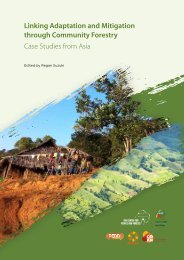Desktop Study on - Regional Climate Change Adaptation ...
Desktop Study on - Regional Climate Change Adaptation ...
Desktop Study on - Regional Climate Change Adaptation ...
You also want an ePaper? Increase the reach of your titles
YUMPU automatically turns print PDFs into web optimized ePapers that Google loves.
Assessment of Capacity Gaps and Needs of South East Asia Countries<br />
in Addressing Impacts, Vulnerability and Adaptati<strong>on</strong> to <strong>Climate</strong> Variability and <strong>Climate</strong> <strong>Change</strong><br />
change focal point. In 2007, Thailand established<br />
the Nati<strong>on</strong>al Board <strong>on</strong> <strong>Climate</strong> <strong>Change</strong> Policy, and<br />
the <strong>Climate</strong> <strong>Change</strong> Coordinating Unit under ONEP<br />
(See Figure 34). The country further established the<br />
Greenhouse Gas Management Organizati<strong>on</strong> (TGO)<br />
as a public organizati<strong>on</strong> under the Ministry and<br />
the Designated Nati<strong>on</strong>al Authority (DNA) for Clean<br />
Development Mechanism (CDM) projects (MRC,<br />
2009).<br />
The membership of the Nati<strong>on</strong>al Board <strong>on</strong> <strong>Climate</strong><br />
<strong>Change</strong> Policy is wide and includes representatives of<br />
line ministries, research institutes and the ec<strong>on</strong>omic<br />
interests. The Board is chaired by the Ministry of<br />
Natural Resources and Envir<strong>on</strong>ment.<br />
Thailand Initial Nati<strong>on</strong>al Communicati<strong>on</strong><br />
under the UNFCCC<br />
Thailand ratified the UNFCCC in March 1995; later,<br />
in August 2002, ratified the Kyoto Protocol. From<br />
1997 to 2000 the country developed the Initial<br />
Nati<strong>on</strong>al Communicati<strong>on</strong> to UNFCCC, which was<br />
funded by Global Envir<strong>on</strong>ment Facility. In 2006, the<br />
Sec<strong>on</strong>d Nati<strong>on</strong>al Communicati<strong>on</strong> to UNFCCC was<br />
commenced.<br />
The initial communicati<strong>on</strong> recalls the c<strong>on</strong>tributi<strong>on</strong><br />
of the country to the internati<strong>on</strong>al efforts <strong>on</strong> climate<br />
change, as a n<strong>on</strong>-Annex I country. The document is an<br />
overview of Thailand’s situati<strong>on</strong> regarding climate<br />
issues and capability to resp<strong>on</strong>d to it together with<br />
mitigati<strong>on</strong> opti<strong>on</strong>s; also it reviews vulnerability and<br />
adaptati<strong>on</strong> strategies, policies and measures taken,<br />
and the areas where Thailand still lacks the capacity<br />
to address climate change problems.<br />
The c<strong>on</strong>tents of the communicati<strong>on</strong> are divided into<br />
nine chapters, starting with the introducti<strong>on</strong> chapter<br />
and finishing with the epilogue. Between both, there<br />
is a descripti<strong>on</strong> of the country characteristics, socioec<strong>on</strong>omic<br />
aspects, climate and topography, energy,<br />
etc. doing afterwards a review of the inventory of<br />
Green House Gases, and the projecti<strong>on</strong>s for all of<br />
them, as well as the available mitigati<strong>on</strong> opti<strong>on</strong>s.<br />
Subsequently, it goes through vulnerability<br />
and adaptati<strong>on</strong> issues, always focusing in five<br />
sectors, which are natural forest, water resources,<br />
agriculture, coastal resources and health. The rest<br />
three chapters are devoted to policies and measures,<br />
financial resources, technology transfer and capacity<br />
building and educati<strong>on</strong> and public awareness.<br />
Nati<strong>on</strong>al Acti<strong>on</strong> Plan <strong>on</strong> <strong>Climate</strong> <strong>Change</strong> and<br />
Nati<strong>on</strong>al Strategy <strong>on</strong> <strong>Climate</strong> <strong>Change</strong><br />
The Nati<strong>on</strong>al Acti<strong>on</strong> Plan <strong>on</strong> <strong>Climate</strong> <strong>Change</strong> of<br />
Thailand, which was completed in 2000, enables the<br />
country to establish a nati<strong>on</strong>al framework <strong>on</strong> climate<br />
change for mitigating emissi<strong>on</strong>s of GHGs and adapting<br />
to the adverse impacts. Nati<strong>on</strong>al goals and objectives<br />
were established for the formulati<strong>on</strong> of the acti<strong>on</strong><br />
plan. The adaptati<strong>on</strong> plans were designed based <strong>on</strong><br />
available informati<strong>on</strong> from systematic assessments<br />
of the key sectors described for the initial nati<strong>on</strong>al<br />
communicati<strong>on</strong>: forests; water resources; coastal<br />
resources; health and agriculture (MRC, 2009).<br />
The Acti<strong>on</strong> Plan involved the establishment of the<br />
Nati<strong>on</strong>al <strong>Climate</strong> <strong>Change</strong> Office (NCCO) and the<br />
Nati<strong>on</strong>al <strong>Climate</strong> <strong>Change</strong> Fund (NCCF) to facilitate<br />
its implementati<strong>on</strong>.<br />
The Thailand’s Strategic Plan <strong>on</strong> <strong>Climate</strong> <strong>Change</strong><br />
2008 – 2012 (B.E. 2551- 2555 (2008‐2012)) was<br />
approved in January 2008 and formulated by the<br />
Ministry of Natural Resources and Envir<strong>on</strong>ment to<br />
resp<strong>on</strong>d to climate change challenges. It aims to be<br />
country’s first resp<strong>on</strong>se to climate change, to remove<br />
existing barriers to climate change implementati<strong>on</strong>,<br />
and to promote an integrated approach of problemsolving<br />
by relevant agencies in various sectors. The<br />
main objective of Thailand’s Strategic Plan <strong>on</strong> <strong>Climate</strong><br />
<strong>Change</strong> (2008‐2012) is to provide a guideline of<br />
nati<strong>on</strong>al resp<strong>on</strong>ses to climate change challenges. It is<br />
essential that nati<strong>on</strong>al‐level and local‐level agencies<br />
with relevant mandates develop their own acti<strong>on</strong><br />
plan that corresp<strong>on</strong>ds to the guidelines set forth<br />
in the Strategic Plan. The Ministry is now initiating<br />
the Acti<strong>on</strong> Plan Development Process am<strong>on</strong>g<br />
relevant agencies, expected to be completed this<br />
year (MRC, 2009). It outlines measures that need to<br />
be undertaken by various agencies, which include<br />
(ONEP, 2008):<br />
Strategy 1: Build capacity to adapt and reduce<br />
vulnerabilities to climate change impacts<br />
Strategy 2: Support greenhouse gas emissi<strong>on</strong>s<br />
reducti<strong>on</strong> and add more carb<strong>on</strong> dioxide sinks<br />
<strong>on</strong> integrity development, which objective is to<br />
reduce greenhouse gas emissi<strong>on</strong>s and improve<br />
producti<strong>on</strong> technology base to clean technology<br />
Strategy 3: Support research and development<br />
to better understand climate change, its impacts<br />
and adaptati<strong>on</strong> and mitigati<strong>on</strong> opti<strong>on</strong>s<br />
Strategy 4: Raise awareness and promote public<br />
participati<strong>on</strong><br />
99

















